Home > Interesting Connections > Music By Masons > W.C. Handy
INTERESTING MASONIC CONNECTIONS
MUSIC BY MASONS
W.C. HANDY
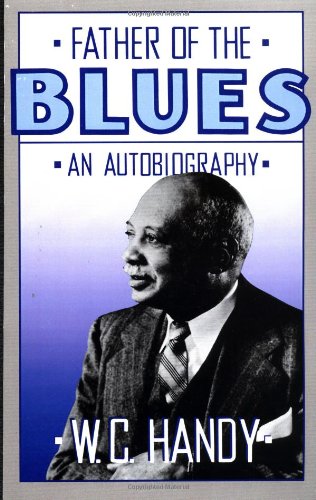
W.C. Handy (1873-1958) is one of the most influential musicians in 20th century American music history.
He was a Freemason. His Master Mason scroll is on display in the W.C. Handy Birthplace Museum in Florence, Alabama, along with several other Masonic items (including tie clips and books) which were among W.C. Handy's personal possessions.
W.C. Handy's autobiography (Fig.1) is a worthwhile read if you're interested in Handy's history.
It doesn't mention the fact that W.C. Handy was a Freemason but does mention an encounter Handy had with a Mason in Batesville, Mississippi which may have saved Handy's life. (See below)
Here are some sites associated with W.C. Handy in Alabama, Mississippi and Tennessee.
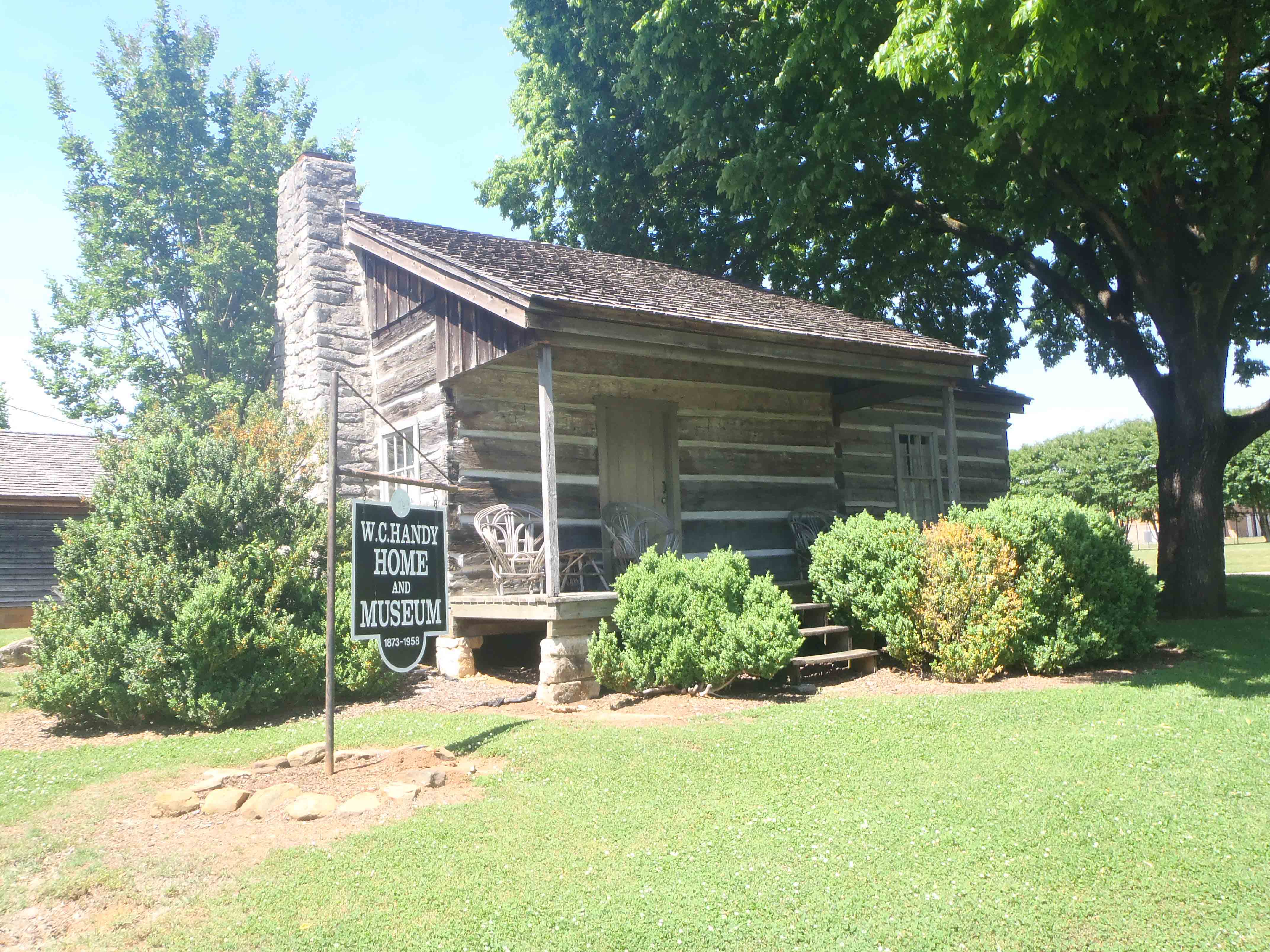
W.C. Handy was born in Florence, Alabama in 1873.
The house he was born in is now a museum called the W.C. Handy Home & Museum. If you're interested in W.C. Handy, this museum is worth seeing if you're in Florence, Alabama.
Handy pursued a career as a travelling musician for several years before finding a steady job as a bandleader in Clarksdale, Mississippi circa 1903.
W.C. Handy's first job as a professional bandleader was in Clarksdale, Mississippi, starting in 1903.
Today there is a Mississippi Department of Archives and History marker at the place W.C. Handy once lived in Clarksdale (Fig.3).
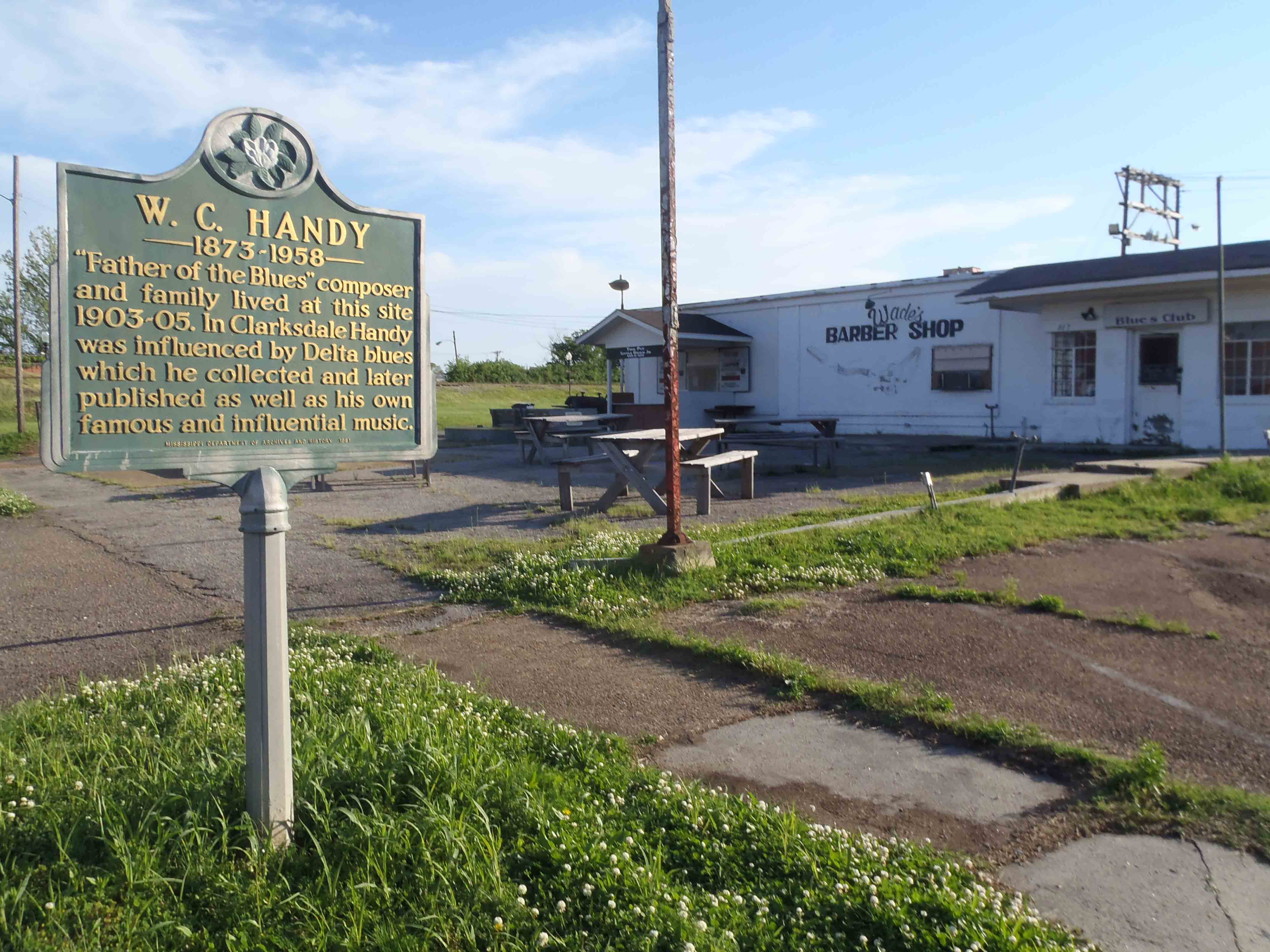
The marker reads:
"W.C. HANDY - 1873-1958 - Father of the Blues composer and family lived at this site 1903-05. In Clarksdale Handy was influenced by the Delta blues which he collected and later published as well as his own famous and influential music."
At the time W.C. Handy lived at this site, he was managing a band that was based in Clarksdale but which travelled to performances throughout Mississippi and the neighbouring states.
W.C Handy also described life at this site in his 1941 autobiography, Father of the Blues:
".......My son Bill was born in Clarksdale. We lived in a frame cottage between others of its kind. The third house away, however, was a shack and a fire trap. Instead of a chimney it had only an elongated stove pipe that poured smoke and simetimes sparks onto the very gable of the house next door. I noticed this danger and cautioned my wife to be ready for a fire. She promptly began holding fire drills with a baby carriage and the three children.
Then one cold night in January a salvo of gun and pistol shots awakened us from our sleep. This was the way of announcing a fire in Clarksdale in those days. I ran to a window and saw the shack disappearing like a matchbox. The flames reached out in our direction time and again. I began considering what was most worth saving among our household effects. There was a collection of books that had a value. There was an upright piano and a guitar that I had bought in Mexico. Mrs. Handy ran for the baby buggy and gathered up the brood. I commenced to struggle with the piano. A few moments later neighbors rushed in and began tossing furniture and bedclothes and glassware throughthe windows.
In the excitement my wife called me to come and help with the babies, but I assured her that was not necessary. They could be easily rolled to safety. The big problem was getting the piano out of danger. I managed to save it, by dint of more muscle than I thought I had, but the next day I had occasion to wonder whether or not the instrument was worth the ridicule that fell upin me.
An old woman yelled to me from across the street, cackling in a high pitched voice about the news that was going around town.
'Oh, I heard all 'bout you, Fess Handy,' she twittered. 'I heard what you done said at the fire.'
'What'd I say at the fire?'
You said, 'Chillun is easy. Never mind de chillun, but it's hard to get another piano.'
After the fire I missed my Mexican guitar. Someone told me that it had been saved by a spry one-legged man. I hurried to his home and asked about the instrument.
'Oh, you mean that box?" he replied oddly, 'Hell, I cut that damn thing up for kindling' "
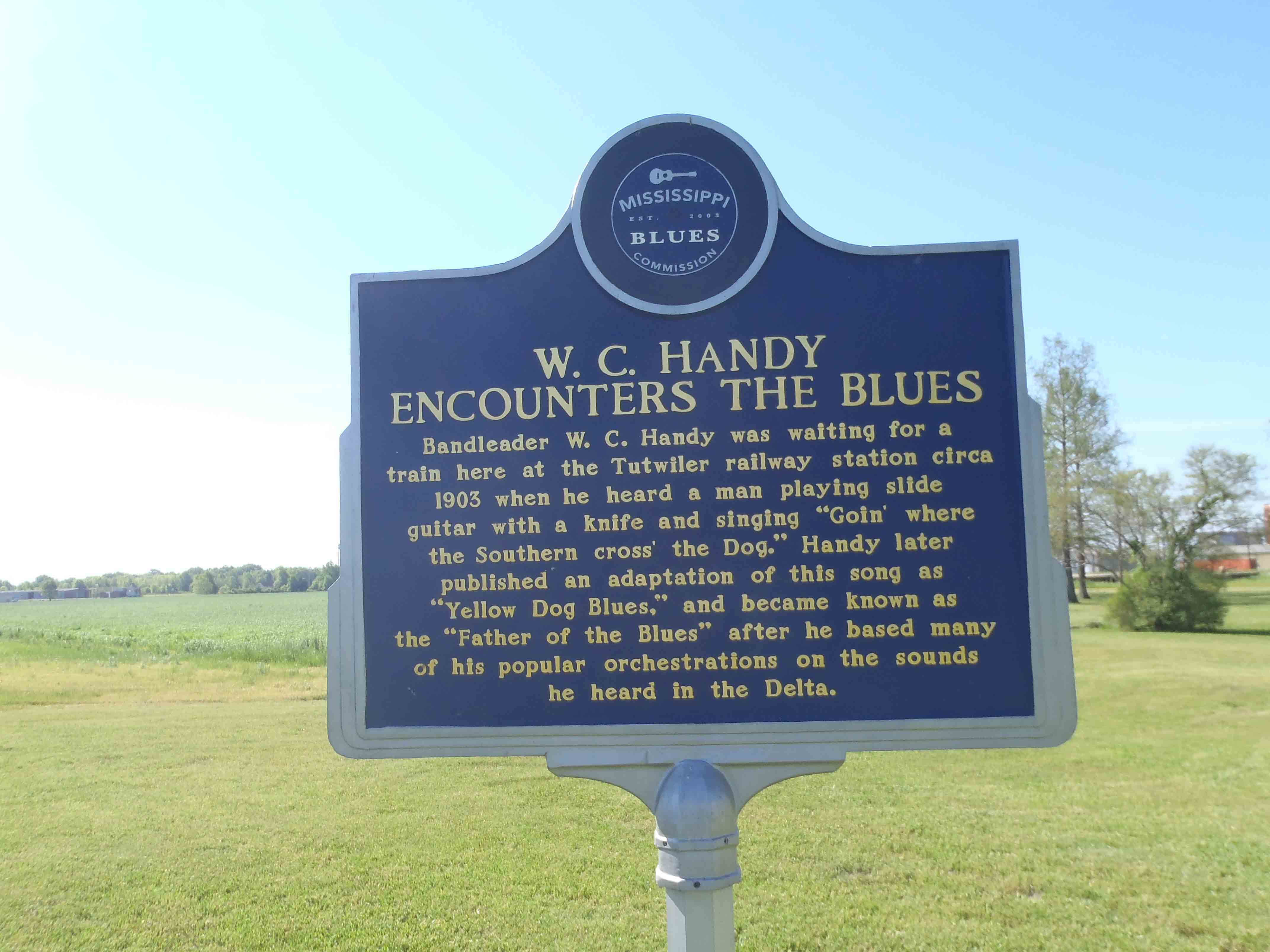
W.C. Handy first encountered the blues circa 1903 while waiting for a train at the railway station in Tutwiler, Mississippi. The Tutwiler train station has since been demolished but there is now a Mississippi Blues Trail marker at the site commemorating the incident.
The marker reads:
"W.C. HANDY ENCOUNTERS THE BLUES
Bandleader W.C. Handy was waiting for a train here at the Tutwiler railway station circa 1903 when he heard a man playing slide guitar with a knife and singing 'Goin' where the Southern cross' the Dog.' Handy later published an adaptation of this song as 'Yellow Dog Blues,' and became known as the 'father of the Blues' after he based many of his popular orchestrations on the sounds he heard in Tutwiler."
Handy recalled this incident in his autobiography as:
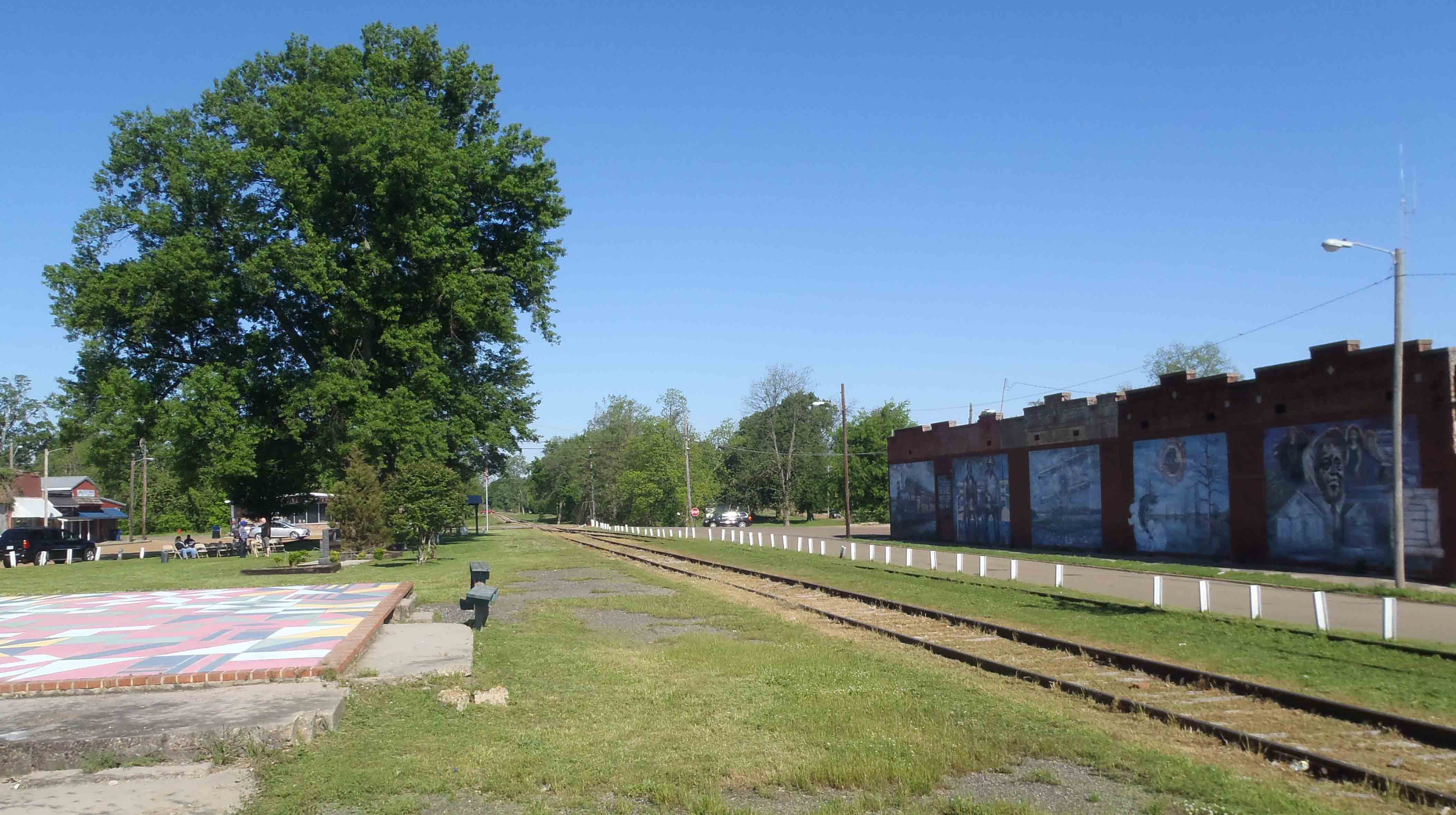
"The band which I found in Clarksdale and the nine-man orchestra which grew out of it did yeoman duty in the Delta. We played for affairs of every description. I came to know by heart every foot of the Delta, even from Clarksdale to Lambert on the Dog and Yazoo City. I could call every stop, water tower and pig path on the Peavine with my eyes closed. It all became a familiar, monotonous round. Then one night in Tutwiler, as I nodded in the railroad station while waiting for a train that had been delayed nine hours, life suddenly took me by the shoulder and wakened me with a start.
A lean, loose-jointed Negro had commenced plunking a guitar beside me while I slept. His clothes were rags, his feet peeped out of his shoes. As he played he pressed a knife on the strings of the guitar in a manner popularized by Hawaiian guitarists who use steel bars. [to see what W.C. Handy was describing, watch the video of Bukka White playing Po' Boy in the early 1960s) The effect was unforgettable. His song, too, struck me instantly.
Goin' where the Southern cross' the Dog.
The singer repeated the line three times, accompanying himself on the guitar with the weirdest music I had ever heard. The tune stayed in my mind. When the singer paused, I leaned over and asked him what the words meant. He rolled his eyes, showing a trace of mild amusement. Perhaps I should have known, but he didn't mind explaining. At Moorhead the eastbound and the westbound met and crossed the north and southbound trains four times a day. This fellow was going where the Southern cross' the Dog, and he didn't care who knew it. He was simply singing about Moorhead as he waited.
That was not unusual. Southern Negroes sang about everything. Trains, steamboats, steam whistles, sledge hammers, fast women, mean bosses, stubborn mules - all become subjects for their songs.They accompany themselves on anything from which they can extract a musical sound or rhythmical effect, anything from a harmonica to a washboard.
In this way, and from these materials, they set the mood for what we now call blues......."
This chance encounter at Tutwiler's railway station sparked W.C. Handy's interest in the blues. From that epiphany in Tutwiler, W.C. Handy changed his own musical direction to a course which led to his becoming one of the most influential figures in the history of American music.
Handy became aware of the commercial possibilities of the Delta blues while his band was playing at a dance in Cleveland, Missippi in 1905.
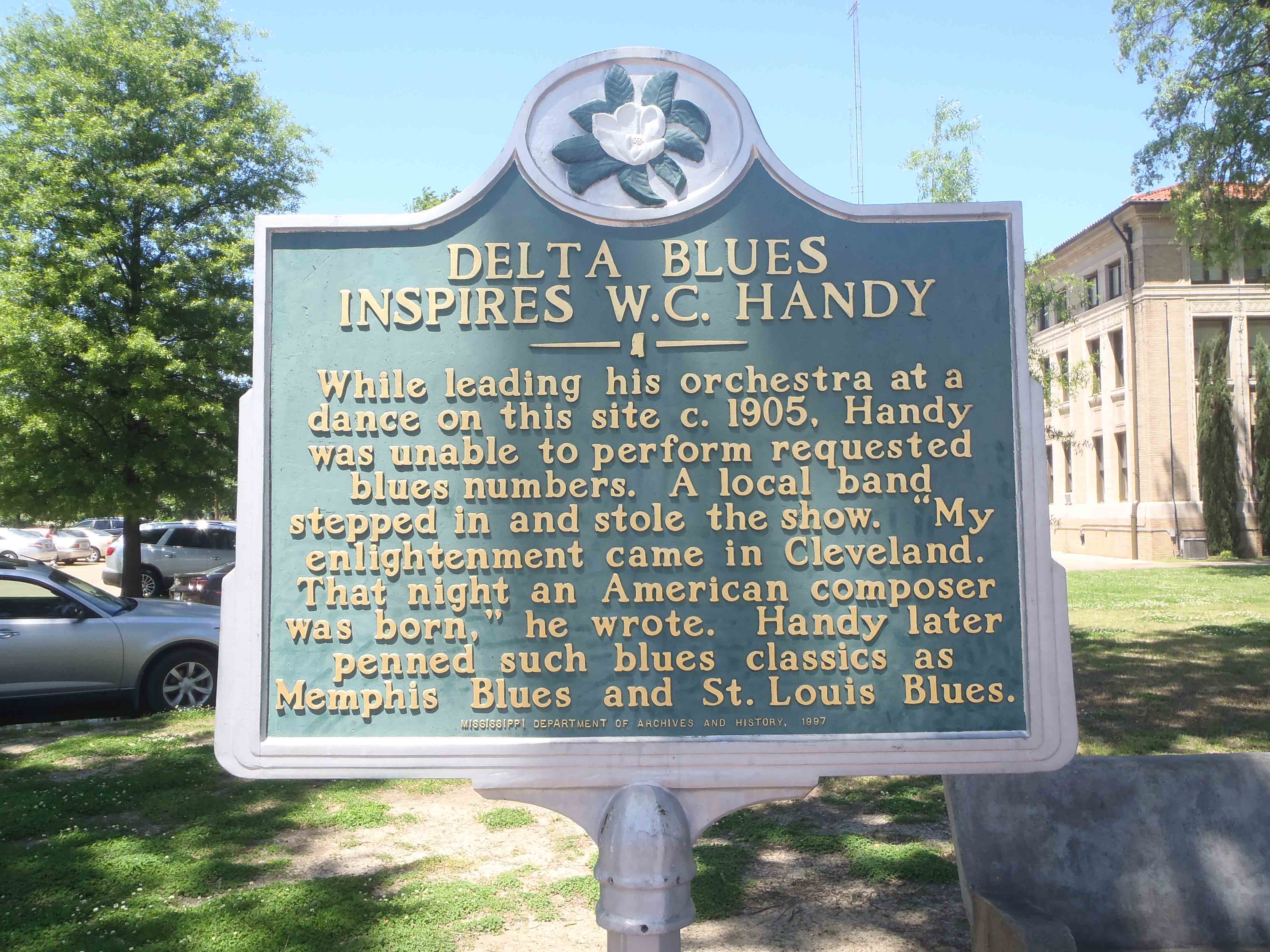
This incident took place on the site of the present day Bolivar County Courthouse in Cleveland, Mississippi and is commemorated by a Mississippi Department of Archives and History marker (Fig.6) and a Mississippi Blues Trail marker (Fig.7), both on the Bolivar County Courthouse grounds.
The Mississippi Department of Archives and History marker reads:
"DELTA BLUES INSPIRES W.C. HANDY - While leading his orchestra at a dance on this site, ca. 1905, Handy was unable to perform requested blues numbers. A local band stepped in and stole the show. 'My enlightenment came in Cleveland. That night an American composer was born,' he wrote. Handy later penned such blues classics as Memphis Blues and St. Louis Blues."
The GPS location of this marker is: N 33° 44.654' W 90° 43.479'
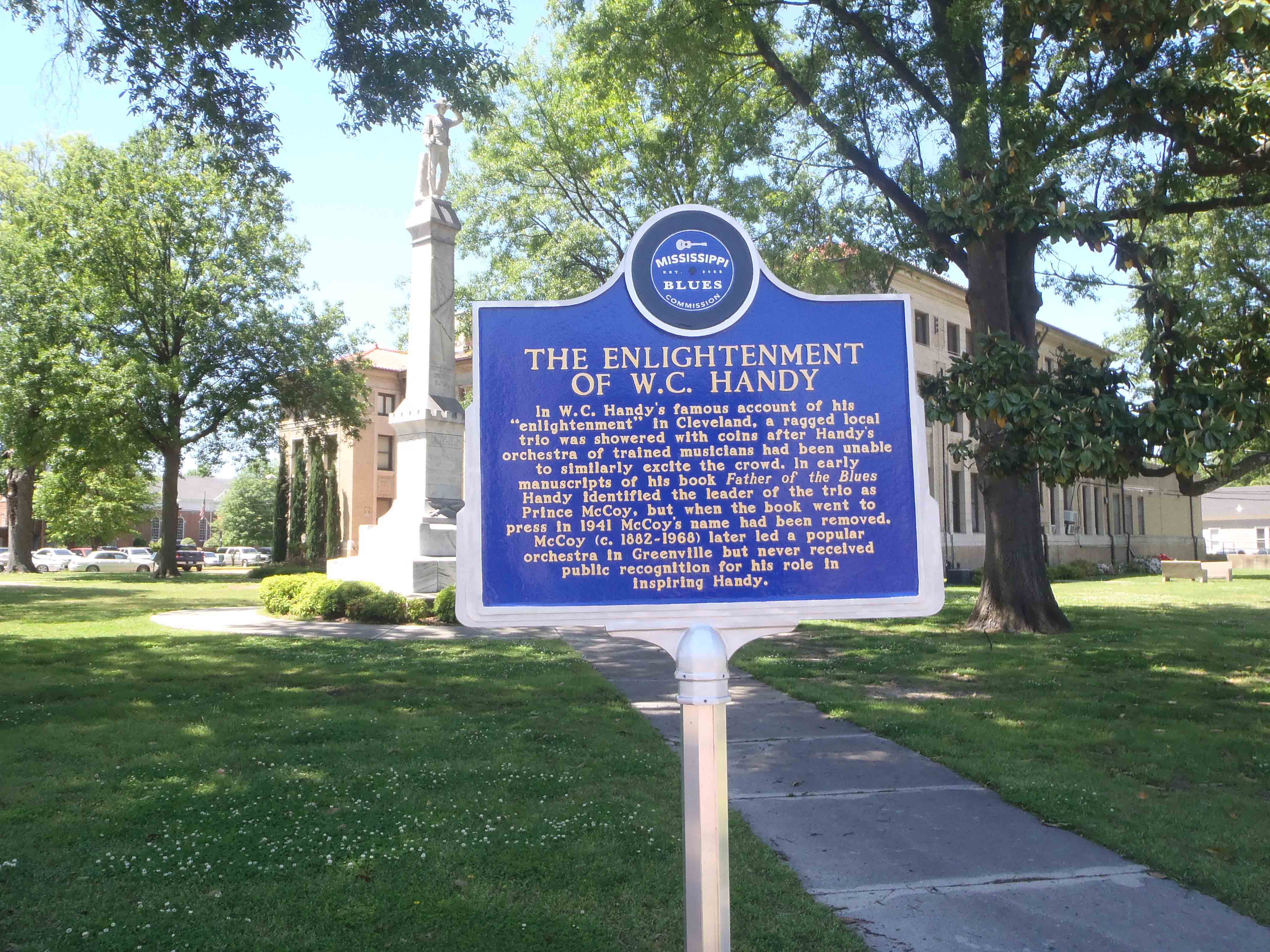
The Mississippi Blues Trail marker at the Bolivar County Courthouse reads:
"THE ENLIGHTENMENT OF W.C. HANDY - In W.C. Handy's famous account of his "enlightenment" in Cleveland, a ragged local trio was showered with coins after Handy's orchestra of trained musicians had been unable to similarly excite the crowd. In early manuscripts of his book Father of the Blues Handy identified the leader of the trio as Prince McCoy, but when the book went to press in 1941 McCoy's name had been removed. McCoy (c. 1882-1968) later led a popular orchestra in Greenville but never received public recognition for his role in inspring Handy."
The GPS location of this marker is: N 33° 44.655' W 90° 43.437'
Here is how W.C. Handy described this event in his autobiography:
"........As a director of many respectable, conventional bands, it was not easy for me to concede that a simple slow-drag and repeat could be rhthym itself. Neither was I ready to believe that this was just what the public wanted. But we live to learn.
My own enlightenment came in Cleveland, Mississippi. I was leading the orchestra in a dance program when someone sent up an odd request. Would we play some of 'our native music,' the note asked. This baffled me. The men in this group could not 'fake' or 'sell it' like minstrel men. They were all musicians who bowed strictly to the authority of printed notes. So we played for our anonymous fan an old-time Southern melody, a melody more sophisticated than native. A few moments later a second note came up. Would we object if a local colored band played a few dances?
Object! That was funny. What hornblower would object to a time-out and a smoke - on pay? We eased out gracefully as the newcomers entered. They were led by a long-legged chocolate boy and their band consisted of just three pieces, a battered guitar, a mandolin and a worn-out bass.
The music they made was pretty well in keeping with their looks. They struck up one of those over-and-over strains that seem to have no very clear beginning and certainly no ending at all. The strumming attained a disturbing monotony, but on and on it went, a kind of stuff that has long been associated with cane rows and levee camps. Thump-thump-thump went their feet on the floor. Their eyes rolled. Their shoulders swayed. It was not really annoying or unpleasant. perhaps 'haunting' is a better word, but I commenced to wonder if anybody besides small town rounders and their running mates would go for it.
The answer was not long in coming. A rain of silver dollars began to fall around the outlandish, stomping feet. The dancers went wild. Dollars, quarters, halves - the shower grew heavier and continued so long I strained my neck to get a better look. There before the boys lay more money than my nine musicians were being paid for the entire engagement. Then I saw the beauty of primitive music. They had the stuff the people wanted. It touched the spot. Their music wanted polishing, but it contained the essence. Folks would pay money for it. The old conventional music was well and good and had its place, no denying that, but there was no virtue in being blind when you had good eyes.
That night a composer was born, an American composer. Those country black boys at Cleveland had taught me something that could not possibly have been gained from books, something that would, however, coause books to be written. Art, in the high-brow sense, was not in my mind. My idea of what constitutes music was changed by the sight of that silver money cascading around the splay feet of a Mississippi string band....."
The dance W.C. Handy played for in Cleveland circa 1905 was held in the Bolivar County Courthouse building. The Courthouse that stood here in 1905 has been replaced by the current Bolivar County Courthouse building.
W.C. Handy's autobiography does not specifically state that Handy was a Freemason (he was) but his description of an incident in Batesville, Mississippi specifically mentions an encounter with a another Mason. Handy does not provide a date for this encounter in Batesville but it was undoubtedly before Handy moved to New York in 1918.
Here is how W.C. Handy descibed the Batesville incident in his autobiography:
"We [W.C. Handy and his band] were playing for a dance in Batesville, Mississippi, when a loafer stepped up and struck one of my men. I protested to my employer, but before he could intervene, the intruder struck me in the eye. A period of wild disorder followed. When this calmed down, we resumed the music, but the fellow waited outside for me. When the dance was over, he came upstairs with a bullwhip to be used on me.
'Run!' someone shouted.
Had I done so, I might have been shot. Instead, I made up my mind to die fighting. Meanwhile a crowd gathered, among them an upstanding man from Sardis named Maddox. I remember Mr. Maddox because of his bright red hair and partly because he was a godsend to me. He stepped up and low-rated the local boys for not protecting me after bringing me there to play for them. Then he turned on the fellow with the whip.
'Hit me, if you dare,' he said. 'I've done more to you than Handy has.' Then he knocked him down and beat him.
Someone again told me to run. Somehow I didn't feel like running. Instead, I stood and watched the battle. Maddox had administered as sound a beating to his opponent as you would want to see, but the fight did not stop there. It spread out, and I could see it was shaping into a battle royal between the local boys and the Sardis crowd. Eventually guns were whipped out, the gangs scattered temporarily and the boys of my band took to cover. During the lull the Sardis crowd prevailed upon the proprietor of the local hardware store to open up and provide them with guns. At the same time I appealed to the town marshal for protection. He scoffed at my plea and went to the aid of the man who had struck me. So at last, with no place else to turn, I took to my heels, and the hunt was on.
All night I hid in the fields. Then in the morning, chilled from the cold, I went to the kitchen door of an elderly white man and explained to him the fix I was in. He was a Mason [emphasis added]. After providing me with breakfast he armed himself with a double-barrelled shotgun and drove me to the train in his buggy.
'If that fellow shows up this morning, I'll fill his hide with buckshot,' he proudly promised as we drove along the road.
When I finally boarded the train, I met most of my boys. They had walked to the next station south. All of them by now carried guns. The conductor, it seems, knowing our band, had armed them with pistols he had gathered from passengers and train men....."
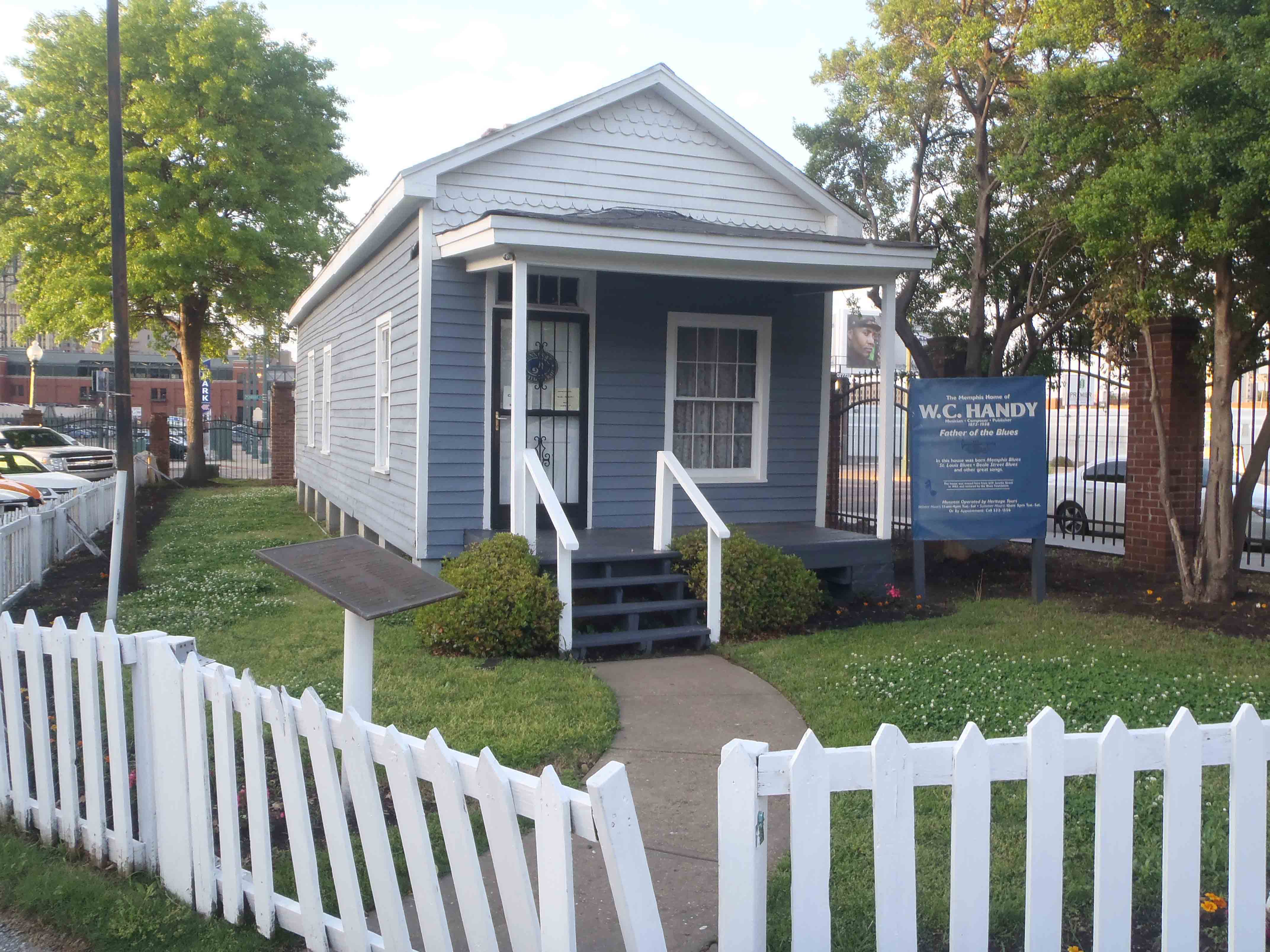
Another site associated with W.C. Handy is Handy's former house - now a museum devoted to W.C. Handy - on Beale Street in downtown Memphis, Tennessee.
Two blocks west of the W.C. Handy house on Beale Street, is Handy Park, a Memphis city park named for W.C. Handy.
Appropriately, there are often blues concerts in Handy Park, particularly during the summer.
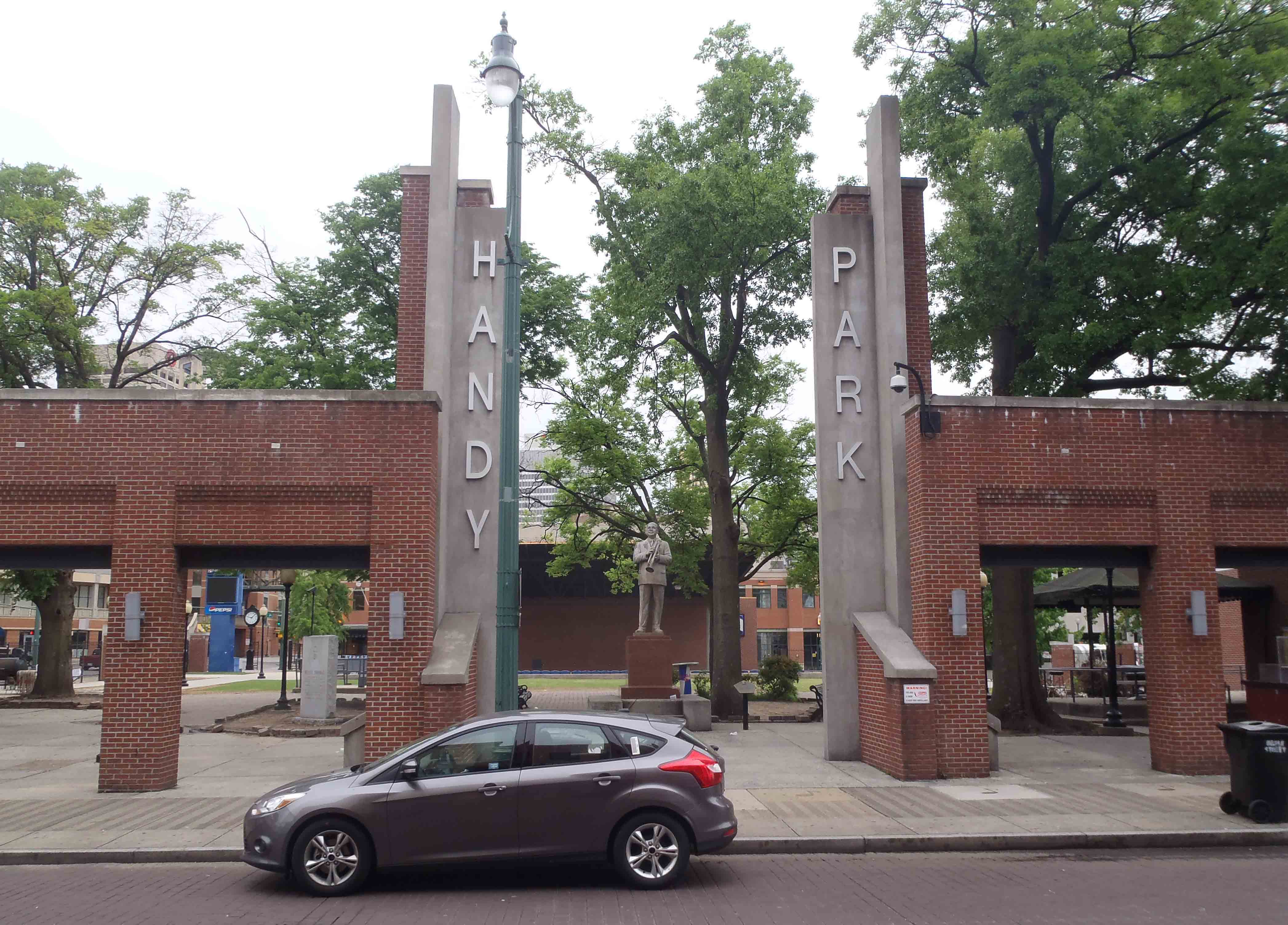
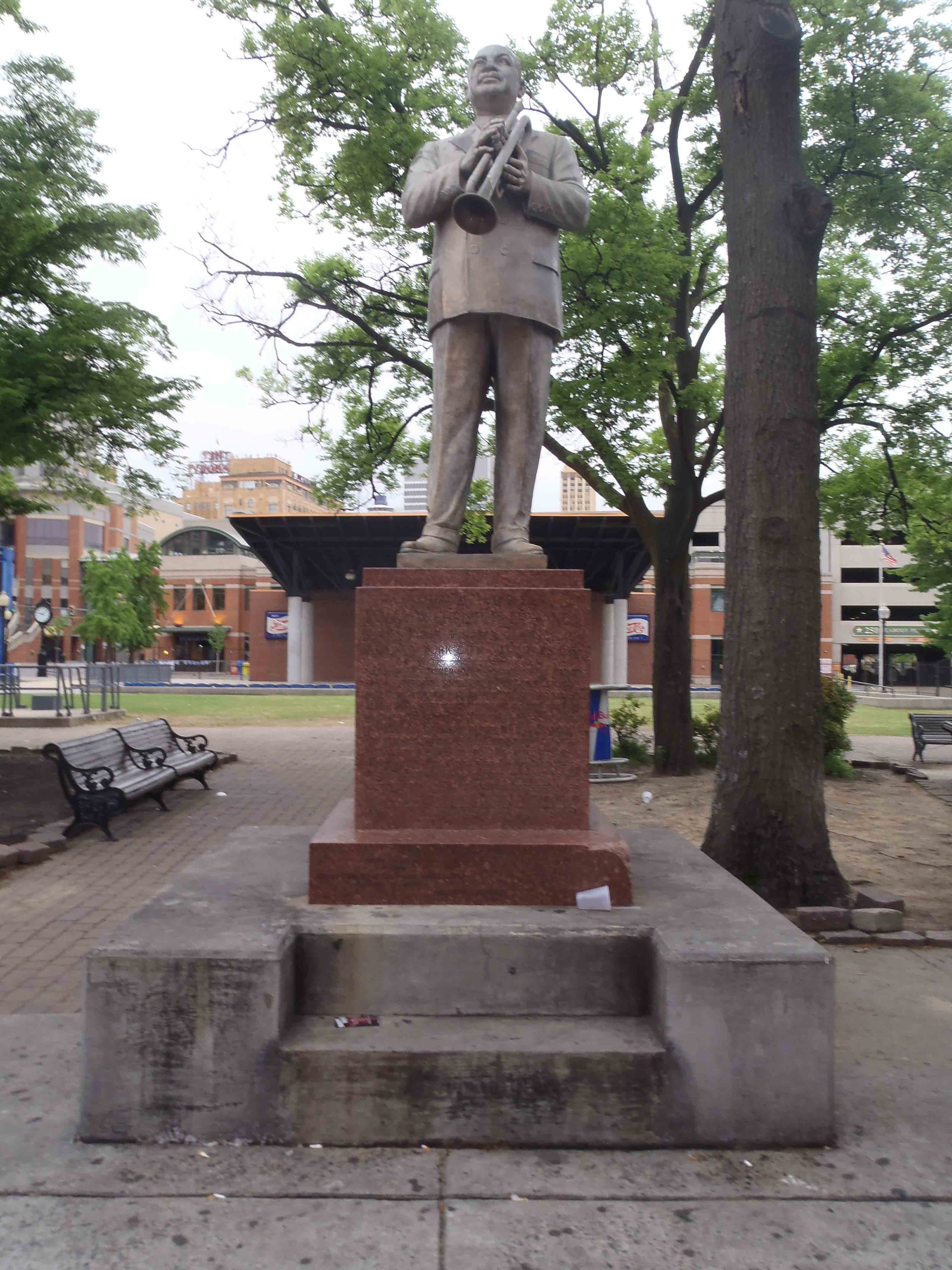
WE RECOMMEND:
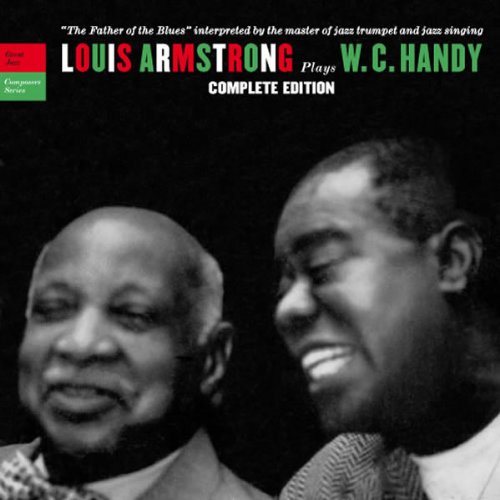 Louis Armstrong Plays W.C. Handy by Louis Armstrong
Louis Armstrong Plays W.C. Handy by Louis Armstrong
We consider this 1956 album the best recording of W.C. Handy material ever released. An excellent album. We recommend the Complete Edition with bonus tracks although there is a shorter release available.
For more recommended music by W.C. Handy, click here.
|| Amazon.com || Amazon.ca || Digital mp3 version || Vinyl LP ||
|| Amazon.com.au || Amazon.at || Amazon.com.br || Amazon.ca || Amazon.cn || Amazon.de || Amazon.fr || Amazon.co.jp || Amazon.es || Amazon.co.uk ||
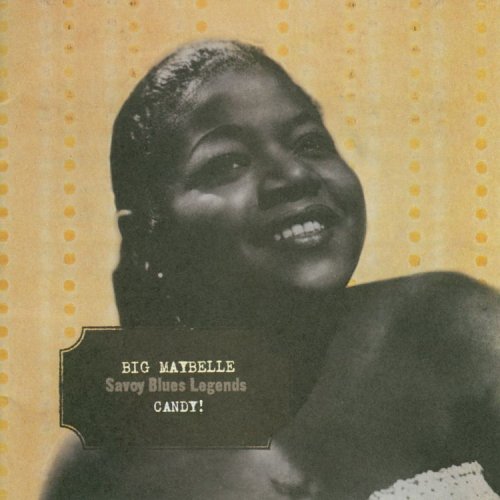 Savoy Blues Legends: Candy! by Big Maybelle
Savoy Blues Legends: Candy! by Big Maybelle
Big Maybelle was inducted into the Blues Hall of Fame in 2011. On this 2CD collection of 1956-59 recordings for the Savoy label, Big Maybelle does 10 W.C. Handy compositions: St. Louis Blues, Hesitating Blues, Ole Miss Blues, Beale Street Blues, Careless Love, Friendless Blues, Yellow Dog Blues, Memphis Blues, Joe Turner Blues, Basement Blues, Harlem Blues and Way Down South Where The Blues Began.
|| Amazon.com || Amazon.ca ||
|| CD version || Digital mp3 version || Vinyl LP ||
|| Amazon.com.au || Amazon.at || Amazon.com.br || Amazon.ca || Amazon.cn || Amazon.de || Amazon.fr || Amazon.co.jp || Amazon.es || Amazon.co.uk ||
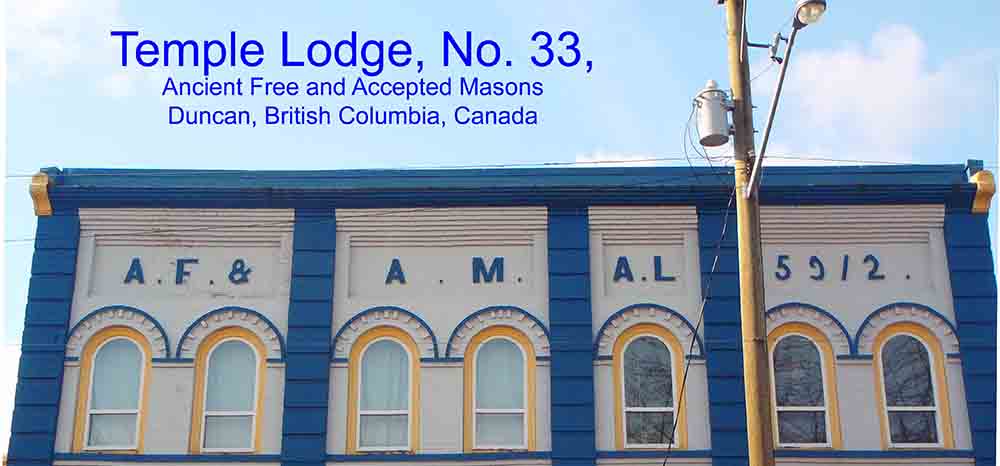
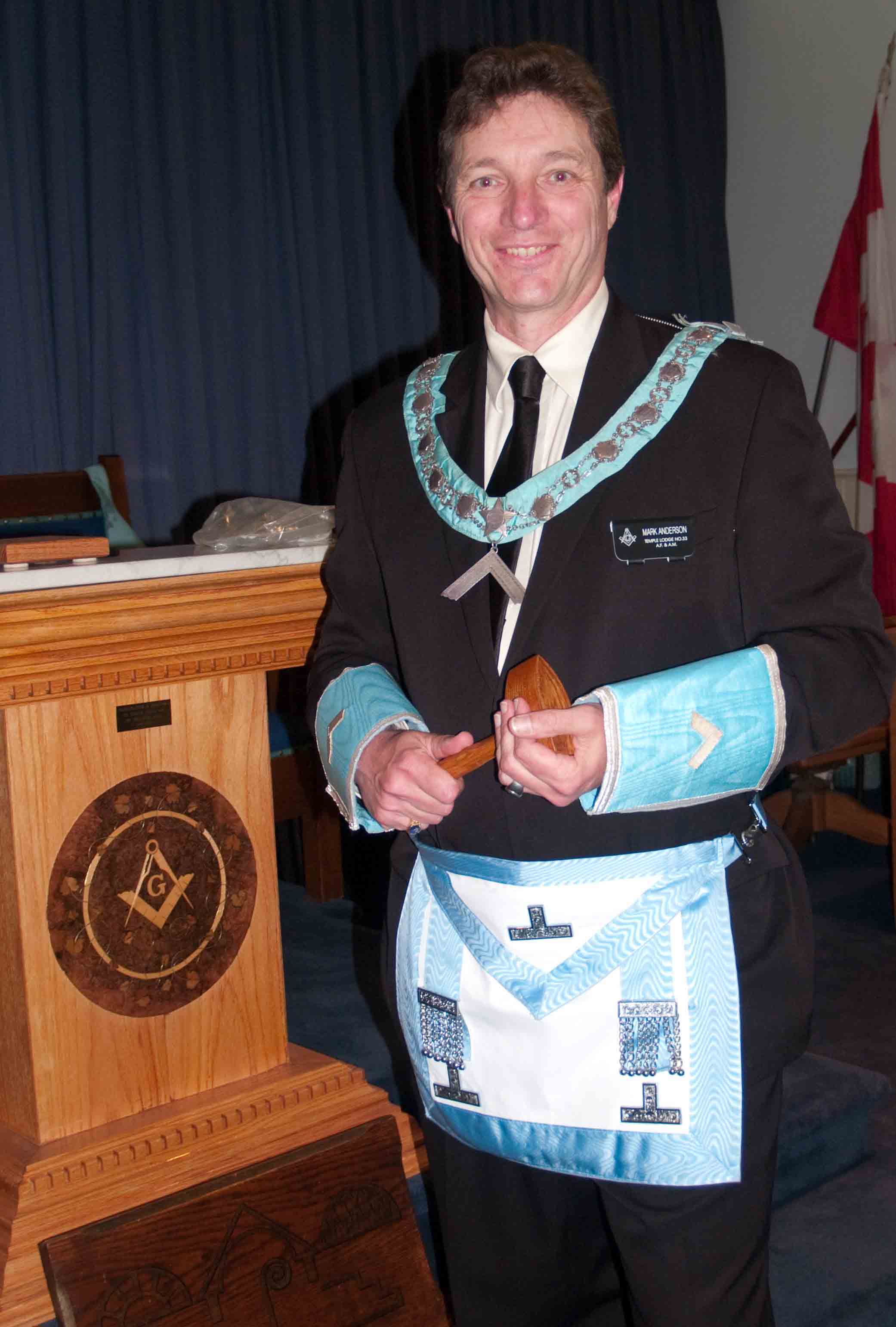 Go to our
Go to our 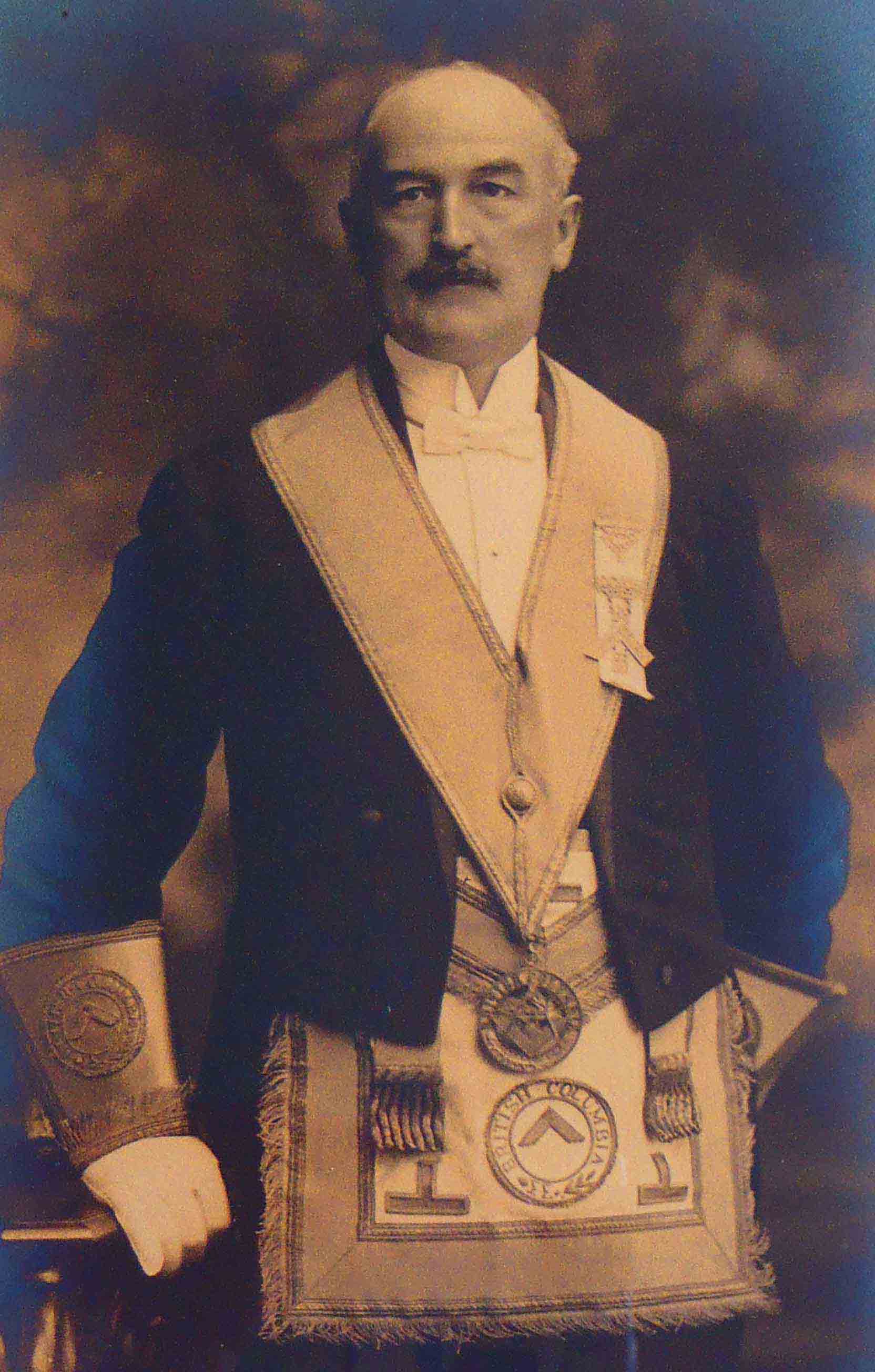
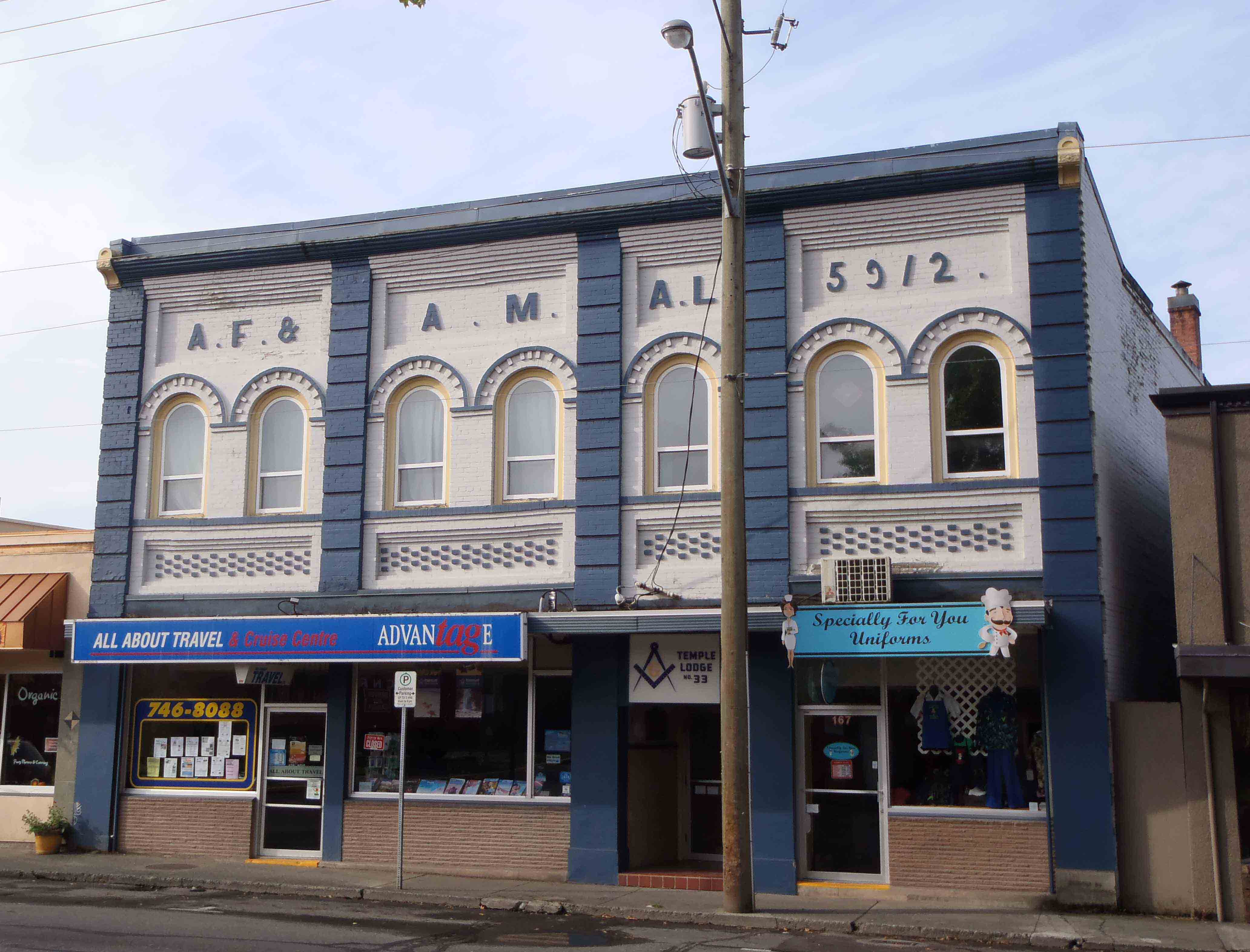
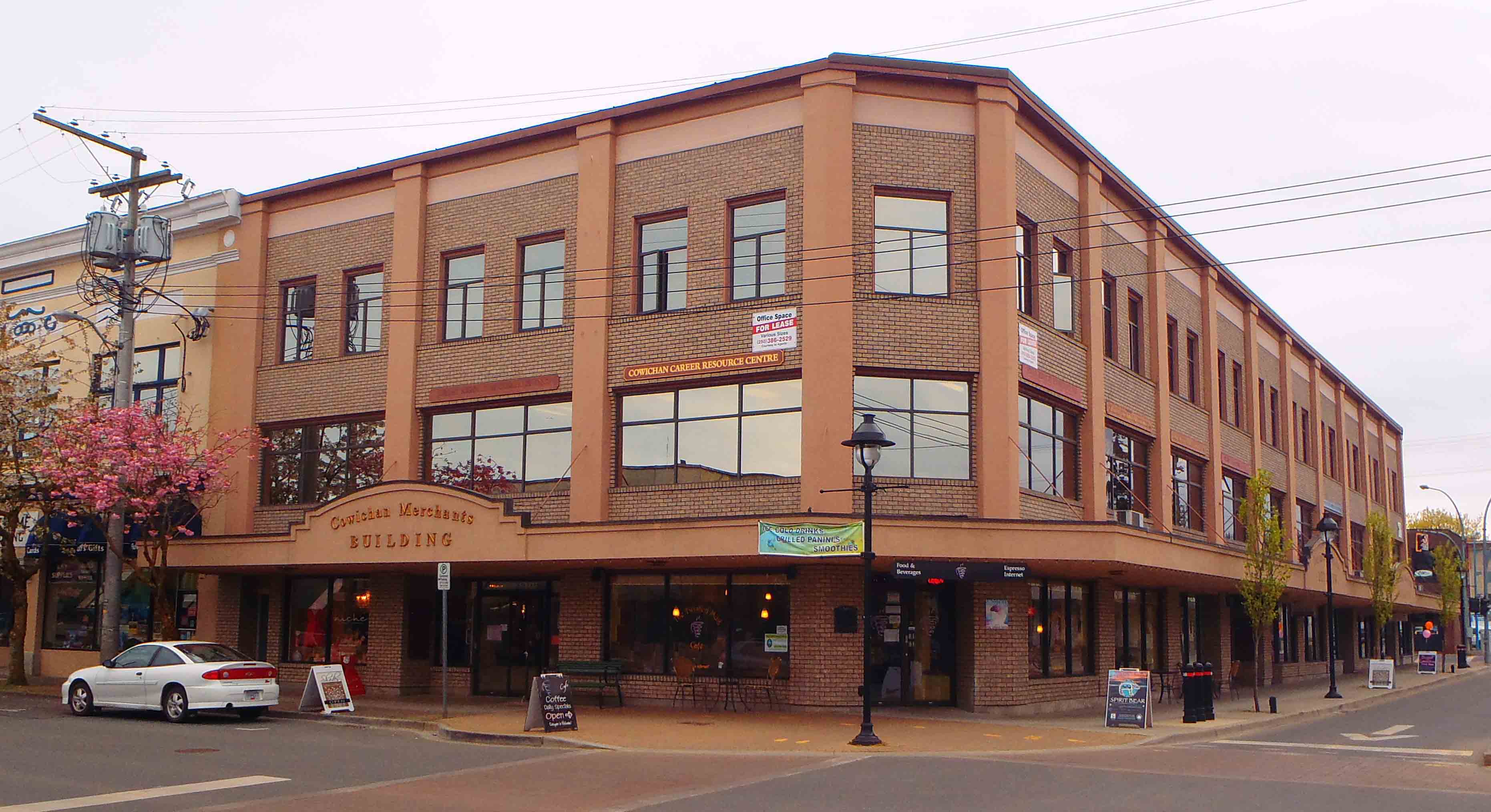
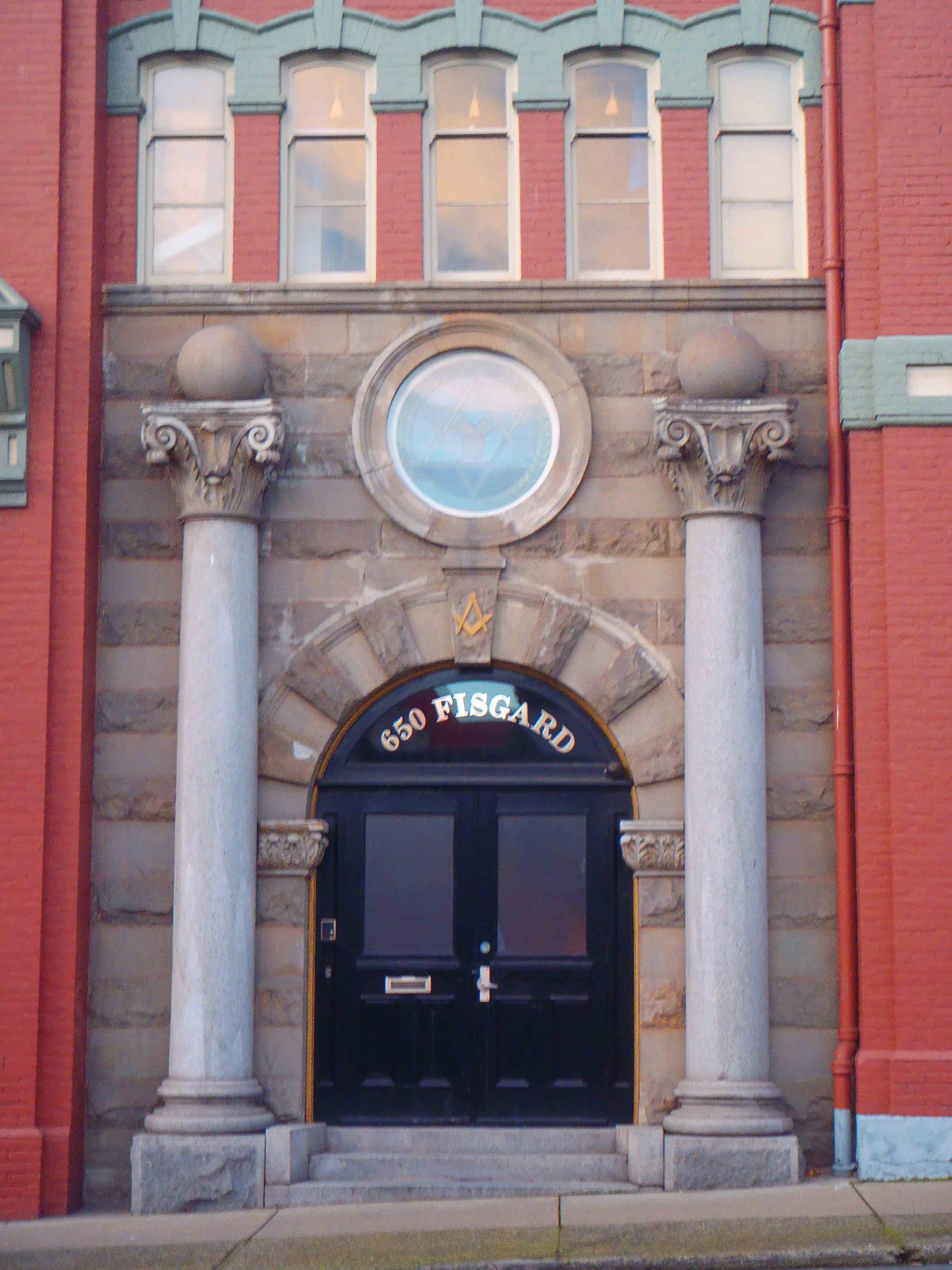
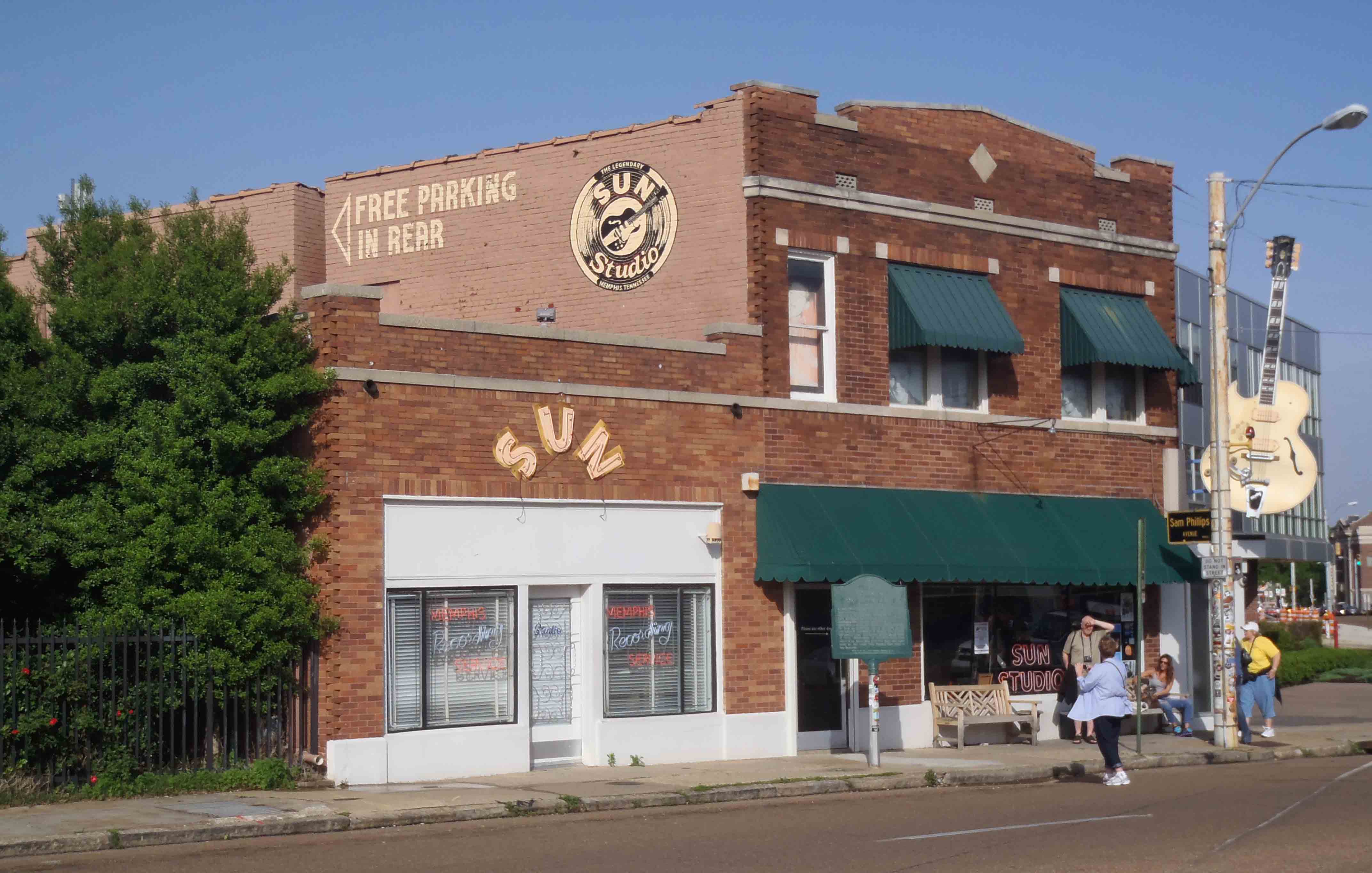 During research or travels we often come across Interesting Connections to Masons and Freemasonry. Our Interesting Connections Page has some interesting Masonic connections uncovered by members of Temple Lodge, No.33, like Sun Studios in Memphis, Tennessee, shown at left.......................
During research or travels we often come across Interesting Connections to Masons and Freemasonry. Our Interesting Connections Page has some interesting Masonic connections uncovered by members of Temple Lodge, No.33, like Sun Studios in Memphis, Tennessee, shown at left.......................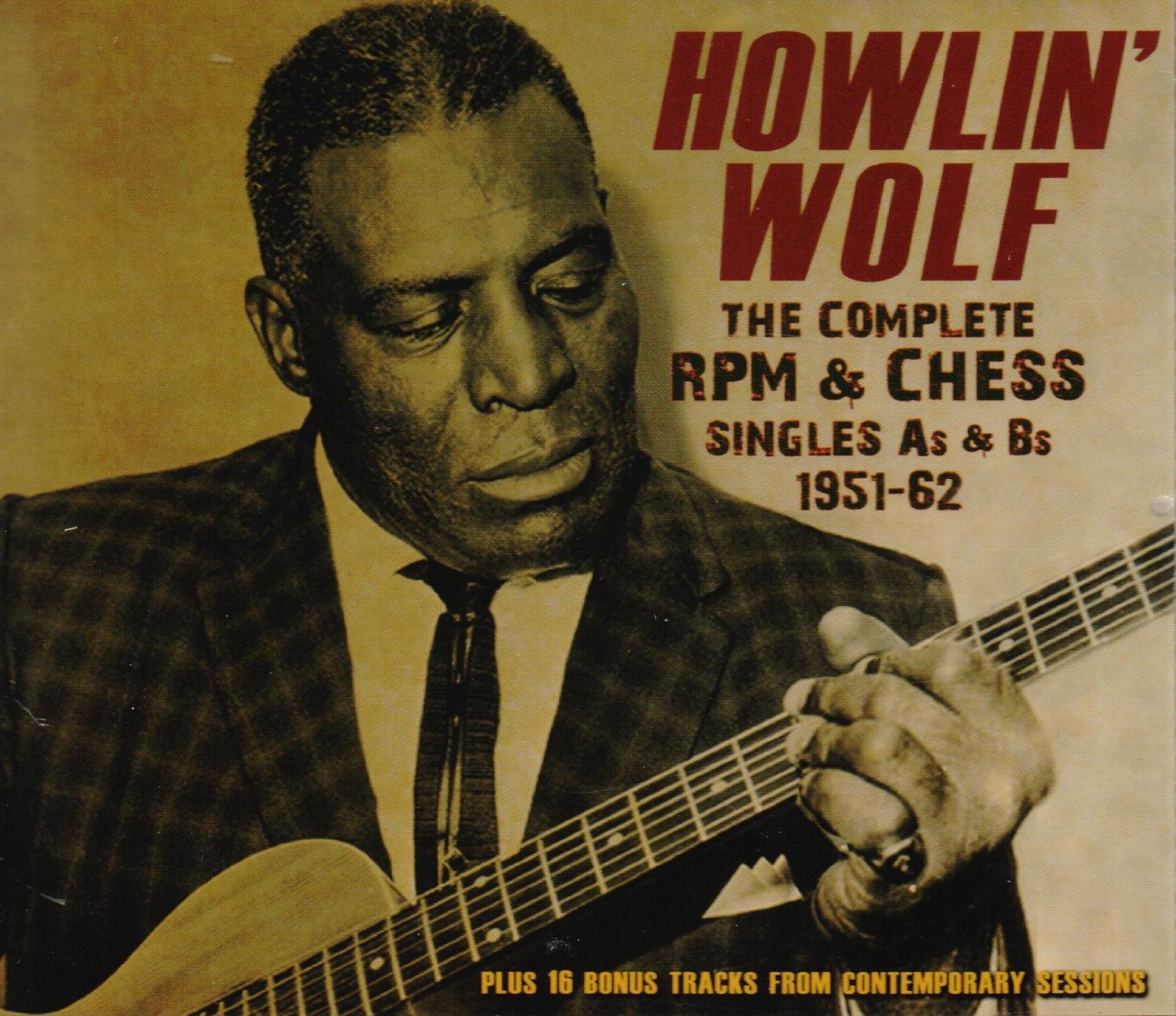 Masonic musicians and composers range from Wolfgang Amadeus Mozart to Howlin' Wolf. Writers include Rudyard Kipling. For music fans and book lovers, here are some links to the works of Masonic musicians, composers and writers..............
Masonic musicians and composers range from Wolfgang Amadeus Mozart to Howlin' Wolf. Writers include Rudyard Kipling. For music fans and book lovers, here are some links to the works of Masonic musicians, composers and writers..............